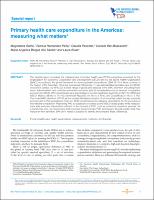Primary health care expenditure in the Americas: measuring what matters
| dc.contributor.author | Rathe, Magdalena | |
| dc.contributor.author | Hernández-Peña, Patricia | |
| dc.contributor.author | Pescetto, Claudia | |
| dc.contributor.author | Van Mosseveld, Cornelis | |
| dc.contributor.author | Santos, Maria Angélica Borges dos | |
| dc.contributor.author | Rivas, Laura | |
| dc.date.accessioned | 2022 | |
| dc.date.available | 2022 | |
| dc.date.issued | 2022 | |
| dc.identifier.citation | Rathe M, Hernández-Peña P, Pescetto C, Van Mosseveld C, Borges dos Santos MA and Rivas L. Primary health care expenditure in the Americas: measuring what matters. Rev Panam Salud Publica. 2022;46:e70. https://doi.org/10.26633/ RPSP.2022.70 | en_US |
| dc.identifier.issn | 1680 5348 | |
| dc.identifier.uri | https://iris.paho.org/handle/10665.2/56088 | |
| dc.description.abstract | [ABSTRACT]. This special report compares the measurement of primary health care (PHC) expenditure proposed by the Organization for Economic Cooperation and Development (OECD) and by the World Health Organization (WHO), according to the global framework for reporting health expenditures (SHA 2011) in three countries in the Region of the Americas. There are conceptual differences: (1) operationalization as basic care, by OECD, versus first contact, by WHO; (2) a wider range of goods and services in the WHO definition (including medicines, administration, and collective preventive services); and (3) consideration only of services in outpatient providers by OECD. PHC expenditures as a percentage of current healthcare spending in 2017 for WHO and OECD: Mexico (43.6% vs. 15.1%); Dominican Republic (41.1% vs. 5.75%), and Costa Rica (31.4% vs. 5.7%). The broad WHO definition of PHC as first contact facilitates inclusion of services that reflect the way countries provide care to their populations. Even so, WHO could improve its category descriptions for the purposes of international comparison. Restricting PHC to outpatient providers (as the OECD does) greatly limits measurement and excludes interventions intrinsic to the concept of PHC, such as collective preventive services. As a transitional step, we recommend that countries should monitor PHC funding and should explain what they include in their definition. SHA 2011 makes it possible to identify and compare these differences. | en_US |
| dc.language.iso | en | en_US |
| dc.relation.ispartofseries | Rev Panam Salud Publica;46, jun. 2022 | |
| dc.rights | Attribution-NonCommercial-NoDerivs 3.0 IGO | * |
| dc.rights.uri | http://creativecommons.org/licenses/by-nc-nd/3.0/igo/ | * |
| dc.subject | Primary Health Care | en_US |
| dc.subject | Health Expenditures | en_US |
| dc.subject | Measurements, Methods and Theories | en_US |
| dc.subject | Atención Primaria de Salud | en_US |
| dc.subject | Gastos en Salud | en_US |
| dc.subject | Mediciones, Métodos y Teorías | en_US |
| dc.subject | Atenção Primária à Saúde | en_US |
| dc.subject | Gastos em Saúde | en_US |
| dc.subject | Medidas, Métodos e Teorias | en_US |
| dc.title | Primary health care expenditure in the Americas: measuring what matters | en_US |
| dc.type | Journal articles | en_US |
| dc.rights.holder | Pan American Health Organization | en_US |
| paho.articletype | Special reports | en_US |
| paho.isfeatured | 0 | en_US |
| dc.identifier.doi | https://doi.org/10.26633/ RPSP.2022.70 | |
| paho.source.centercode | US1.1 | en_US |
| paho.relation.languageVersion | 10665.2/56016 | es |
| paho.relation.languageVersion | 10665.2/55852 | es |
| dc.relation.ispartofjournal | Revista Panamericana de Salud Pública | es_ES |
| dc.relation.ispartofjournal | Pan American Journal of Public Health |
Files in this item
This item appears in the following Collection(s)
-
Pan American Journal of Public Health
Revista Panamericana de Salud Pública





